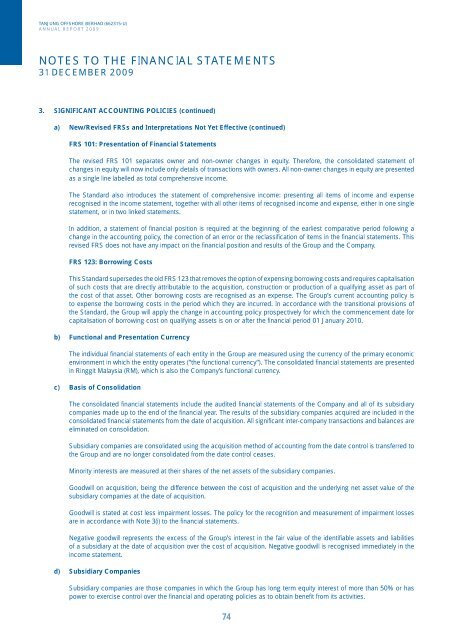TANJUNG OFFSHORE BERHAD
TANJUNG OFFSHORE BERHAD
TANJUNG OFFSHORE BERHAD
Create successful ePaper yourself
Turn your PDF publications into a flip-book with our unique Google optimized e-Paper software.
<strong>TANJUNG</strong> <strong>OFFSHORE</strong> <strong>BERHAD</strong> (662315-U)<br />
ANNUAL REPORT 2009<br />
NOTES TO THE FINANCIAL STATEMENTS<br />
31 DECEMBER 2009<br />
3. SIGNIFICANT ACCOUNTING POLICIES (continued)<br />
a) New/Revised FRSs and Interpretations Not Yet Effective (continued)<br />
FRS 101: Presentation of Financial Statements<br />
The revised FRS 101 separates owner and non-owner changes in equity. Therefore, the consolidated statement of<br />
changes in equity will now include only details of transactions with owners. All non-owner changes in equity are presented<br />
as a single line labelled as total comprehensive income.<br />
The Standard also introduces the statement of comprehensive income: presenting all items of income and expense<br />
recognised in the income statement, together with all other items of recognised income and expense, either in one single<br />
statement, or in two linked statements.<br />
In addition, a statement of fi nancial position is required at the beginning of the earliest comparative period following a<br />
change in the accounting policy, the correction of an error or the reclassifi cation of items in the fi nancial statements. This<br />
revised FRS does not have any impact on the fi nancial position and results of the Group and the Company.<br />
FRS 123: Borrowing Costs<br />
This Standard supersedes the old FRS 123 that removes the option of expensing borrowing costs and requires capitalisation<br />
of such costs that are directly attributable to the acquisition, construction or production of a qualifying asset as part of<br />
the cost of that asset. Other borrowing costs are recognised as an expense. The Group’s current accounting policy is<br />
to expense the borrowing costs in the period which they are incurred. In accordance with the transitional provisions of<br />
the Standard, the Group will apply the change in accounting policy prospectively for which the commencement date for<br />
capitalisation of borrowing cost on qualifying assets is on or after the fi nancial period 01 January 2010.<br />
b) Functional and Presentation Currency<br />
The individual fi nancial statements of each entity in the Group are measured using the currency of the primary economic<br />
environment in which the entity operates (“the functional currency”). The consolidated fi nancial statements are presented<br />
in Ringgit Malaysia (RM), which is also the Company’s functional currency.<br />
c) Basis of Consolidation<br />
The consolidated fi nancial statements include the audited fi nancial statements of the Company and all of its subsidiary<br />
companies made up to the end of the fi nancial year. The results of the subsidiary companies acquired are included in the<br />
consolidated fi nancial statements from the date of acquisition. All signifi cant inter-company transactions and balances are<br />
eliminated on consolidation.<br />
Subsidiary companies are consolidated using the acquisition method of accounting from the date control is transferred to<br />
the Group and are no longer consolidated from the date control ceases.<br />
Minority interests are measured at their shares of the net assets of the subsidiary companies.<br />
Goodwill on acquisition, being the difference between the cost of acquisition and the underlying net asset value of the<br />
subsidiary companies at the date of acquisition.<br />
Goodwill is stated at cost less impairment losses. The policy for the recognition and measurement of impairment losses<br />
are in accordance with Note 3(i) to the fi nancial statements.<br />
Negative goodwill represents the excess of the Group’s interest in the fair value of the identifi able assets and liabilities<br />
of a subsidiary at the date of acquisition over the cost of acquisition. Negative goodwill is recognised immediately in the<br />
income statement.<br />
d) Subsidiary Companies<br />
Subsidiary companies are those companies in which the Group has long term equity interest of more than 50% or has<br />
power to exercise control over the fi nancial and operating policies as to obtain benefi t from its activities.<br />
74


